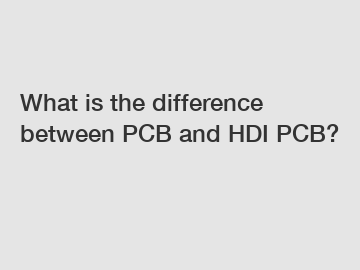Jan. 23, 2024
Electronic Components & Supplies
In today's highly interconnected world, printed circuit boards (PCBs) play a crucial role in countless electronic devices. These intricate boards facilitate the flow of electricity, enabling the seamless functioning of smartphones, computers, medical devices, and everything in between. As technology continually advances, PCB designs have also evolved, giving rise to High-Density Interconnect PCBs (HDI PCBs). In this blog, we will delve into the differences between the two, shedding light on their unique characteristics and applications.
1. PCBs - The Backbone of Electronic Devices:
PCBs have been a staple in electronic devices for several decades now. A typical PCB consists of a substrate (base material), copper layers, and components such as resistors, capacitors, and integrated circuits. These layers are connected through conductive pathways, often referred to as "traces" or "tracks." Traditional PCBs are known for their reliability and cost-effectiveness, making them suitable for a wide variety of applications.

2. HDI PCBs - The Evolutionary Leap:
HDI PCBs, on the other hand, represent a significant advancement in PCB technology. High-Density Interconnect refers to the utilization of increasingly smaller components and denser routing capabilities on a smaller surface area. This technology allows for improved signal integrity, reduced power consumption, and enhanced functionality in smaller electronic devices.
3. Layer Count: The Key Differentiator:
One of the fundamental differences between traditional PCBs and HDI PCBs lies in their layer count. Traditional PCBs usually have fewer layers, ranging from one to four, while HDI PCBs have multiple layers, often surpassing eight or more. By adding extra layers, HDI PCBs can accommodate a higher number of complex components and provide optimal space for routing.
4. Miniaturization and Component Placement:
The ability to accommodate small and fine-pitch components is another significant distinction between the two types of PCBs. HDI PCBs offer increased component density, with features as small as 0.4mm or even smaller. This miniaturization allows for greater design flexibility in smaller devices, meeting the demands of modern consumer electronics that emphasize size and efficiency.
5. Advanced Routing Techniques:
To accommodate the smaller components, HDI PCBs employ advanced routing techniques such as blind vias, buried vias, and micro vias. Blind vias connect the outer layer to one or more inner layers, while buried vias connect multiple inner layers. Micro vias are even smaller, providing connections between adjacent layers within the PCB stack-up. These advanced techniques offer a higher density of interconnections, enabling increased functionality while minimizing signal interference.
6. Signal Integrity and Performance:
Signal integrity is an essential consideration in PCB design. HDI PCBs excel in maintaining signal integrity due to shorter interconnection lengths and reduced electromagnetic interference. By minimizing signal loss and optimizing signal transmission, HDI PCBs enhance the overall performance and reliability of electronic devices.
7. Application Specifics:
While traditional PCBs find applications in a wide spectrum of industries, HDI PCBs are particularly suited for devices with highly complex circuitry, where space is at a premium. Mobile phones, tablets, wearable devices, aerospace and defense equipment, medical devices, and high-performance computing systems often rely on HDI PCBs to achieve the desired functionality in a compact form factor.
Conclusion:
The evolution of PCB technology has given rise to the High-Density Interconnect PCBs, revolutionizing the electronics industry. HDI PCBs employ advanced routing techniques, increased layer counts, and miniaturized components to achieve exceptional functionality in compact devices. With improved signal integrity, reduced power consumption, and optimal use of space, HDI PCBs play a crucial role in enabling cutting-edge technological advancements in diverse sectors. As technology continues to advance, the demand for HDI PCBs will likely surge, further propelling innovation and shaping the future of electronics.
Are you interested in learning more about Lead Free HASL PCB , Lead Free HASL PCB , automotive pcb design ? Contact us today to secure an expert consultation!
Previous: Which new features can enhance the functionality of a 1.7 Inch TFT LCD Display?
Next: Which 0.96 inch TFT LCD display offers the best value for money?
If you are interested in sending in a Guest Blogger Submission,welcome to write for us!
All Comments ( 0 )